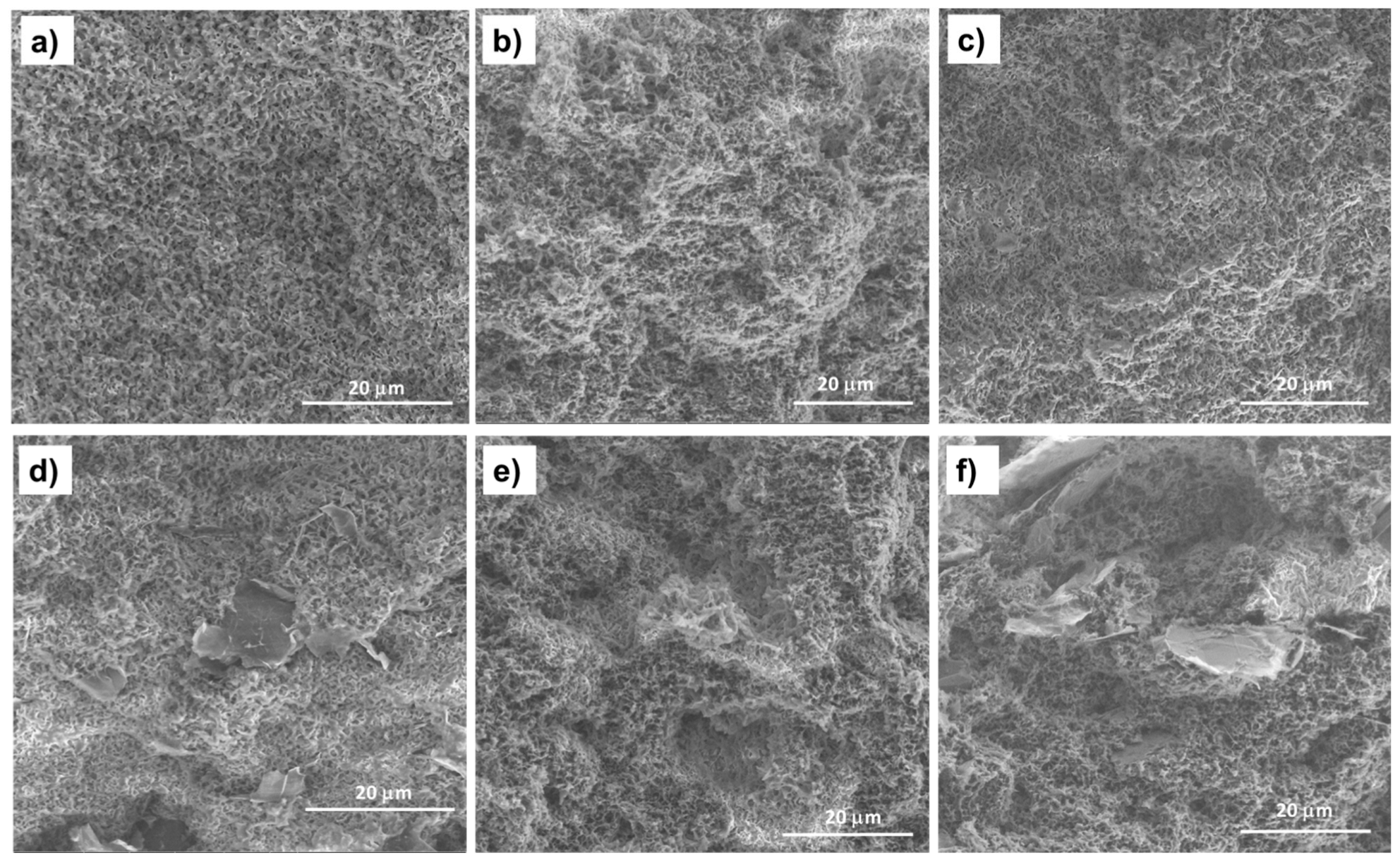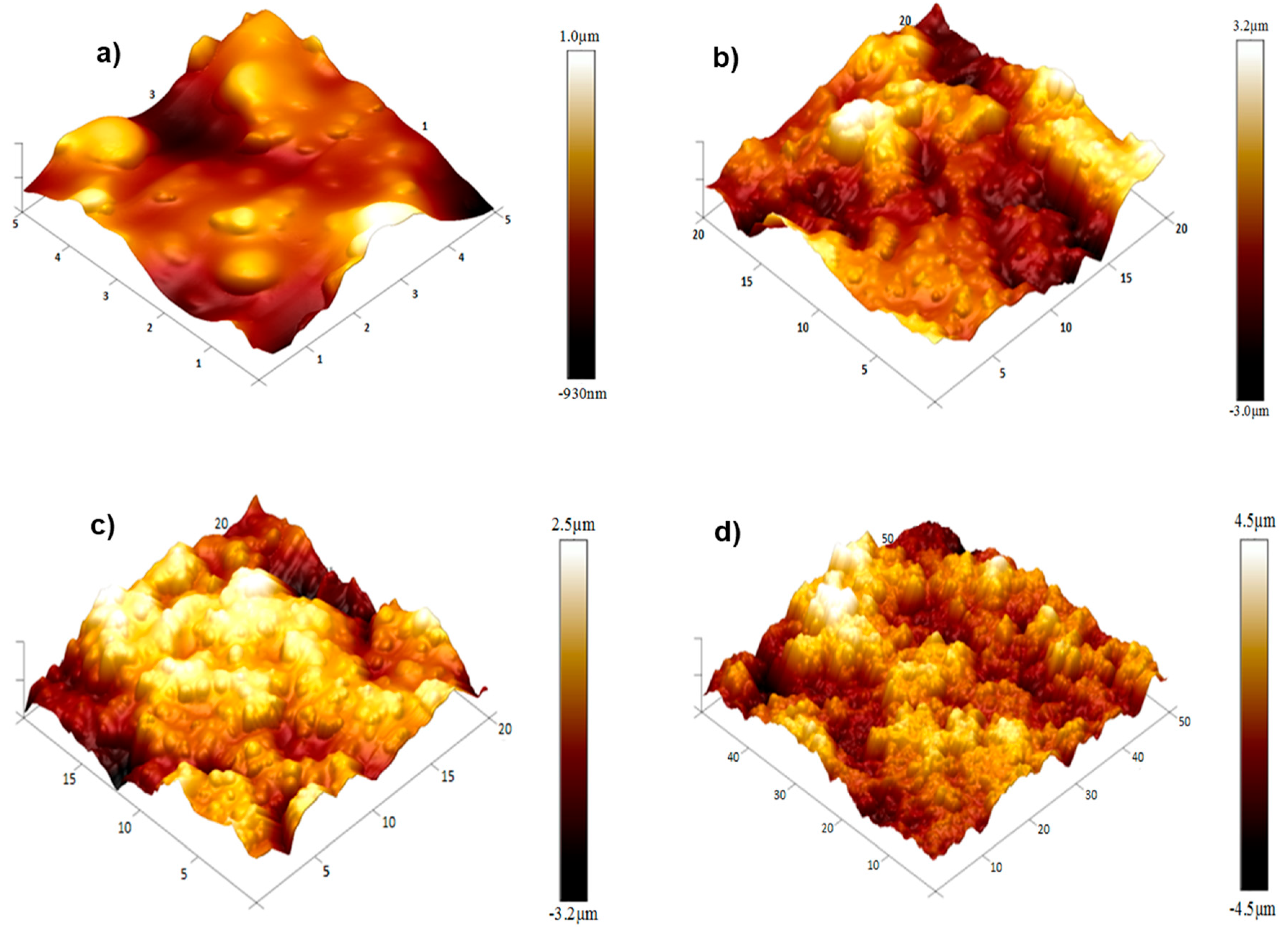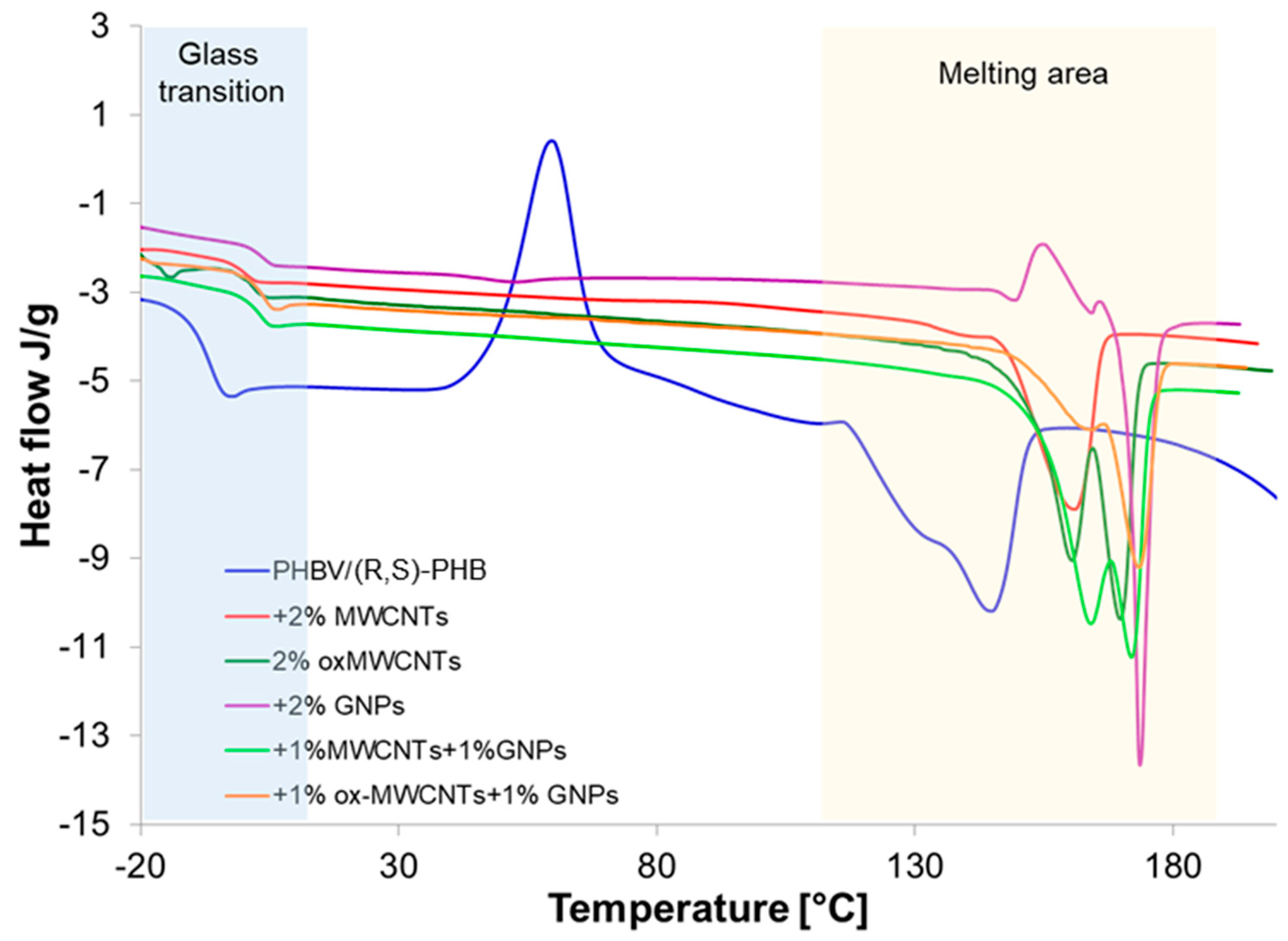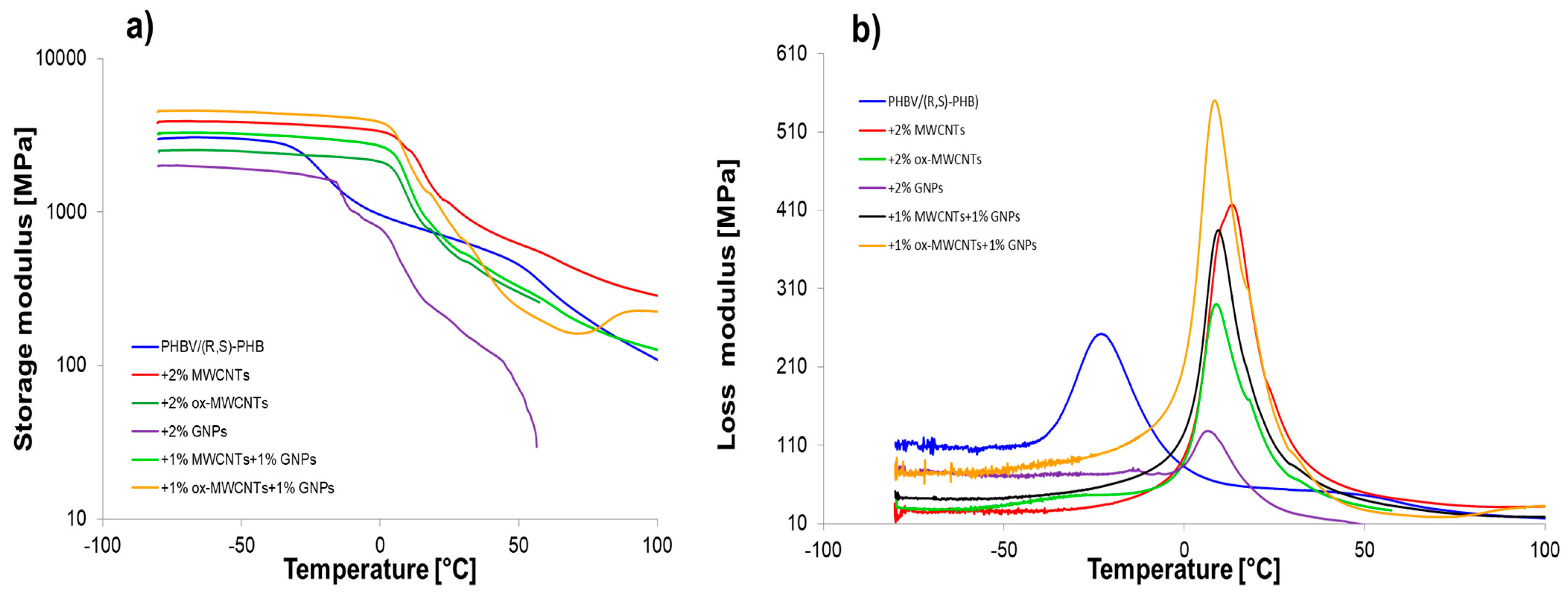Tailoring the Conductivity and Flexibility of Natural Poly(3-hydroxybutyrate-co-3-hydroxyvalerate)-Based Biocomposites by Introduction of Carbon Nanomaterials and Atactic Poly-3-hydroxybutyrate
Abstract
1. Introduction
2. The Experimental Section
2.1. Materials
2.2. Procedures
2.2.1. Oxidation of MWCNTs
2.2.2. The Synthesis of Poly[(R,S)-3-hydroxybutyrate], (R,S)-PHB
2.2.3. The Preparation of Thin Films of Biopolymer Composites
2.3. Characterization
2.3.1. X-Ray Diffraction
2.3.2. Scanning Electron Microscopy
2.3.3. Atomic Force Microscopy (AFM)
2.3.4. Cryogenic Transmission Electron Microscopy (Cryo-TEM) Measurements
2.3.5. Differential Scanning Calorimetry
2.3.6. Dynamic Mechanical Analysis
2.3.7. Electrical and Piezoresistive Characterization
3. Results and Discussion
3.1. Characterization of Polymer and Graphene Materials Used in Composites
3.2. Scanning Electron Microscopy c (SEM) Characterization of the PHBV/(R,S)-PHB Blend
3.3. AFM Characterization
3.4. Cryo-TEM Characterization
3.5. The Characterization and Crystallinity of the Biopolymer Matrix by XRD and DSC
3.6. Dynamic Mechanical Studies
3.7. Electrical and Piezoresistive Characterization
4. Conclusions
- A study of the crystallinity degree of the polymer components in the PHBV/(R,S)-PHB blend, determined with the help of DSC and XRD methods, proved that the addition of (R,S)-PHB reduced the crystallinity of PHBV in the final mixture. Oppositely, the introduction of graphene fillers resulted in an increase in the PHBV crystallinity and a greater increase found in the composite containing 1% ox-CNTs+1%GNPs, and in the composite containing only GNPs.
- The porous morphology of the PHBV/(R,S)-PHB blend remains unchanged in the composites after the introduction of 2 wt.% graphene nanomaterials. Significant strengthening of the fracture surface was observed by AFM imaging for the graphene/biopolymer composites, which leads to a decrease in the crack number and an increase in the irregularity. TEM analysis showed a smaller size distribution of the spherical particle of PHBV/(R,S)-PHB in the composites compared to pure PHBV/(R,S)-PHB.
- The storage modulus representing the stiffness both in the glassy and melting regions decreased significantly when oxidized carbon nanotubes and GNP were used as individual fillers in the PHB/(R,S)-PHB blend. The highest increase in the storage modulus was found for the composite with ox-MWCNTs and GNPs demonstrating an effect of synergy in the case of oxidized MWCNTs and GNPs on the viscoelastic properties of the composite. The result also suggests the elastic susceptibility of the network of filler particles in the polymer to the deformation from the external sources and strong adhesion at the interface between the filler and polymer phases. The smaller values of the width at half of the peak of the loss modulus of all composites compared to the polymer blend confirms the strongly bonded filler to the polymer phases.
- The electrical conductivity of composites was observed to depend on the structure of graphene nanomaterials and their distribution in the PHBV/(R,S)-PHB matrix, as well as the interactions at the polymer–filler interface observed by SEM. The most promising piezoresistive responses were noted for composites with 1%ox-MWCNTs+1%GNPs and 1%MWCNTs+1%GNPs. However, a 1.5% deformation and recovery did not affect the conductivity of the PHBV/(R,S)-PHB +1%MWCNTs+1%GNP system, while for the system with oxidized carbon nanotubes, the resistance increases by approximately 0.2%. In addition, this deformation has a permanent effect on the conductive network, resulting in a decrease in the response of composites with ox-MWCNTs and GNPs at higher deformations, which was not observed for the biopolymer system with MWCNTs/GNPs.
Author Contributions
Funding
Institutional Review Board Statement
Informed Consent Statement
Data Availability Statement
Conflicts of Interest
References
- de Sousa Junior, R.R.; dos Santos, C.A.S.; Ito, N.M.; Suqueira, A.N.; Lackner, M.; dos Santos, D.J. PHB Processability and Property Improvement with Linear-Chain Polyester Oligomers Used as Plasticizers. Polymers 2022, 14, 4197. [Google Scholar] [CrossRef] [PubMed]
- Danko, M.; Mosnáčková, K.; Vykydalová, A.; Kleinová, A.; Puškárová, A.; Pangallo, D.; Bujdoš, M.; Mosnáček, J. Properties and Degradation Performances of Biodegradable Poly(Lactic Acid)/Poly(3-Hydroxybutyrate) Blends and Keratin Composites. Polymers 2021, 13, 2693. [Google Scholar] [CrossRef] [PubMed]
- Frone, A.N.; Nicolae, C.A.; Eremia, M.C.; Tofan, V.; Ghiurea, M.; Chiulan, I.; Radu, E.; Damian, C.M.; Panaitescu, D.M. Low Molecular Weight and Polymeric Modifiers as Toughening Agents in Poly(3-hydroxybutyrate) Films. Polymers 2020, 12, 2446. [Google Scholar] [CrossRef] [PubMed]
- Raffaela, A.; Costa, M.; Ito, E.N.; Cavalho, L.H.; Canedo, E.L. Non-Isothermal Melt Crystallization Kinetics of Poly(3-hydroxybutyrate), Poly(butylene adipate-co-terephthalate) and Its Mixture. Polímeros 2019, 5169, 1–16. [Google Scholar]
- Nowak, A.P.; Trzciński, K.; Zarach, Z.; Li, J.; Roda, D.; Szkoda, M. Poly(Hydroxybutyrate-Co-Hydroxyvalerate) as a Biodegradable Binder in a Negative Electrode Material for Lithium-Ion Batteries. Appl. Surf. Sci. 2022, 606, 154933. [Google Scholar] [CrossRef]
- Panaitescu, D.M.; Ionita, E.R.; Nicolae, C.A.; Gabor, A.R.; Ionita, M.D.; Trusca, R.; Lixandru, B.E.; Codita, I.; Dinescu, G. Poly(3-Hydroxybutyrate) Modified by Nanocellulose and Plasma Treatment for Packaging Applications. Polymers 2018, 10, 1249. [Google Scholar] [CrossRef]
- Kurcok, P.; Śmiga, M.; Jedliński, Z. β-Butyrolactone Polymerization Initiated with Tetrabutylammonium Carboxylates: A Novel Approach to Biomimetic Polyester Synthesis. J. Polym. Sci. A Polym. Chem. 2002, 40, 2184–2189. [Google Scholar] [CrossRef]
- Focarete, M.L.; Scandola, M.; Dobrzynski, P.; Kowalczuk, M. Miscibility and Mechanical Properties of Blends of (L)-Lactide Copolymers with Atactic Poly(3-Hydroxybutyrate). Macromolecules 2002, 35, 8472–8477. [Google Scholar] [CrossRef]
- Szeluga, U.; Kumanek, B.; Trzebicka, B. Composites: Part A Synergy in Hybrid Polymer/Nanocarbon Composites. A Review. Compos. Part A 2015, 73, 204–231. [Google Scholar] [CrossRef]
- Xu, J.; Cao, Z.; Zhang, Y.; Yuan, Z.; Lou, Z.; Xu, X.; Wang, X. Chemosphere A Review of Functionalized Carbon Nanotubes and Graphene for Heavy Metal Adsorption from Water: Preparation, Application, and Mechanism. Chemosphere 2018, 195, 351–364. [Google Scholar] [CrossRef]
- Kuilla, T.; Bhadra, S.; Yao, D.; Hoon, N.; Bose, S.; Hee, J. Progress in Polymer Science Recent Advances in Graphene Based Polymer Composites. Prog. Polym. Sci. 2010, 35, 1350–1375. [Google Scholar] [CrossRef]
- Mahamud, S.N.S.; Ganesan, O.; Pisal, M.H.M.; Rabat, N.E. Effect of Graphene Nanoplatelet Addition on the Electrical Conductivity of Poly(Hydroxybutyrateco-Hydroxyvalerate) Biocomposites. J. Phys. Conf. Ser. 2021, 2080, 012010. [Google Scholar]
- Papadopoulou, E.L.; Basnett, P.; Paul, U.C.; Marras, S.; Ceseracciu, L.; Roy, I.; Athanassiou, A. Green Composites of Poly(3-Hydroxybutyrate) Containing Graphene Nanoplatelets with Desirable Electrical Conductivity and Oxygen Barrier Properties. ACS Omega 2019, 4, 19746–19755. [Google Scholar] [CrossRef] [PubMed]
- Piao, M.; Na, J.; Choi, J.; Kim, J.; Kennedy, G.P.; Kim, G.; Roth, S.; Dettlaff-weglikowska, U. Increasing the Thermoelectric Power Generated by Composite Films Using Chemically Functionalized Single-Walled Carbon Nanotubes. Carbon 2013, 62, 430–437. [Google Scholar] [CrossRef]
- Do Amaral Montanheiroa, T.L.; Cristóvan, F.H.; Machado, J.P.B.; Tada, D.B.; Durán, N.; Lemes, A.P. Effect of MWCNT Functionalization on Thermal and Electrical Properties of PHBV/MWCNT Nanocomposites. J. Mater. Res. 2014, 760, 55–65. [Google Scholar] [CrossRef]
- Yang, L.; Li, S.; Zhou, X.; Liu, J.; Li, Y.; Yang, M.; Yuan, Q.; Zhang, W. Effects of Carbon Nanotube on the Thermal, Mechanical, and Electrical Properties of PLA/CNT Printed Parts in the FDM Process. Synth. Met. 2019, 253, 122–130. [Google Scholar] [CrossRef]
- dos Anjos, E.G.R.; Brazil, T.R.; de Melo Morgado, G.F.; Antonelli, E.; Rezende, M.C.; Pessan, L.A.; Moreira, F.K.V.; Marini, J.; Passador, F.R. Renewable PLA/PHBV Blend-Based Graphene Nanoplatelets and Carbon Nanotube Hybrid Nanocomposites for Electromagnetic and Electric-Related Applications. ACS Appl. Electron. Mater. 2023, 5, 6165–6177. [Google Scholar] [CrossRef]
- Cataldi, P.; Steiner, P.; Raine, T.; Lin, K.; Kocabas, C.; Young, R.J.; Bissett, M.; Kinloch, I.A.; Papageorgiou, D.G. Multifunctional Biocomposites Based on Polyhydroxyalkanoate and Graphene/Carbon Nanofiber Hybrids for Electrical and Thermal Applications. ACS Appl. Polym. Mater. 2020, 2, 3525–3534. [Google Scholar] [CrossRef]
- Moshkriz, A.; Shahroodi, Z.; Darvishi, R. Fabrication of Novel Strain Sensors from Green TPV Nanocomposites Based on Poly(3-Hydroxybutyrate-Co-3-Hydroxyvalerate) (PHBV)/Silicone Rubber/Silicon-Modified Graphene Oxide. RSC Adv. 2023, 13, 17818–17833. [Google Scholar] [CrossRef]
- Talaniuk, V.; Godzierz, M.; Iurhenko, M.; Sikorska, W.; Adamus, G. Conductive Polymer Biocomposites Based on Poly (3-Hydroxybutyrate) and Poly (Butylene Adipate-Co-Terephthalate) with Various Graphene Fillers for Thermistor Applications. J. Therm. Anal. Calorim. 2024, 149, 2593–2607. [Google Scholar] [CrossRef]
- Vidhate, S.; Innocentini-Mei, L.; D’Souza, N.A. Mechanical and Electrical Multifunctional Poly(3-Hydroxybutyrate-Co-3- Hydroxyvalerate)-Multiwall Carbon Nanotube Nanocomposites. Polym. Eng. Sci. 2012, 52, 1367–1374. [Google Scholar] [CrossRef]
- Shan, G.F.; Gong, X.; Chen, W.P.; Chen, L.; Zhu, M.F. Effect of Multi-Walled Carbon Nanotubes on Crystallization Behavior of Poly(3-Hydroxybutyrate-Co-3-Hydroxyvalerate). Colloid. Polym. Sci. 2011, 289, 1005–1014. [Google Scholar] [CrossRef]
- Lemes, A.P.; Montanheiro, T.L.D.A.; Durán, N.; da Silva, A.P. Phbv/Mwcnt Films: Hydrophobicity, Thermal and Mechanical Properties as a Function of Mwcnt Concentration. J. Compos. Sci. 2019, 3, 12. [Google Scholar] [CrossRef]
- Montanheiro, T.L.A.; Campos, T.M.B.; Montagna, L.S.; Da Silva, A.P.; Ribas, R.G.; De Menezes, B.R.C.; Passador, F.R.; Thim, G.P. Influence of CNT Pre-Dispersion into PHBV/CNT Nanocomposites and Evaluation of Morphological, Mechanical and Crystallographic Features. Mater. Res. Express 2019, 6, 105375. [Google Scholar] [CrossRef]
- Adamus, G.; Domiński, A.; Kowalczuk, M.; Kurcok, P.; Radecka, I. From Anionic Ring-Opening Polymerization of β-Butyrolactone to Biodegradable Poly(Hydroxyalkanoate)s: Our Contributions in This Field. Polymers 2021, 13, 4365. [Google Scholar] [CrossRef]
- ISO 11357-3; Plastics—Differential Scanning Calorimetry (DSC). Part 3: Determination of Temperature and Enthalpy of Melting and Crystallization. ISO: Geneva, Switzerland, 2018.
- Le Delliou, B.; Vitrac, O.; Benihya, A.; Guinault, A.; Domenek, S. Development of Extrusion Blown Films of Poly(3-Hydroxybutyrate-Co-3-Hydroxyvalerate) Blends for Flexible Packaging. J. Appl. Polym. Sci. 2024, 141, e55240. [Google Scholar] [CrossRef]
- Barham, P.J.; Keller, A.; Otun, E.L.; Wills, H.H.; Holmes, P.A. Crystallization and Morphology of a Bacterial Thermoplastic: Poly-3-Hyd Roxybutyrate. J. Mater. Sci. 1984, 19, 2781–2794. [Google Scholar]
- Javadi, A.; Kramschuster, A.J.; Pilla, S.; Lee, J.; Gong, S.; Turng, L.S. Processing and Characterization of Microcellular PHBV/PBAT Blends. Polym. Eng. Sci. 2010, 50, 1440–1448. [Google Scholar] [CrossRef]
- Godzierz, M.; Toroń, B.; Szperlich, P.; Olesik, P.; Kozioł, M. X-Ray Diffraction and Piezoelectric Studies during Tensile Stress on Epoxy/SbSI Nanocomposite. Sensors 2022, 22, 3886. [Google Scholar] [CrossRef]
- Guzenko, N.; Godzierz, M.; Kurtyka, K.; Hercog, A.; Nocoń-Szmajda, K.; Gawron, A.; Szeluga, U.; Trzebicka, B.; Yang, R.; Rümmeli, M.H. Flexible Piezoresistive Polystyrene Composite Sensors Filled with Hollow 3D Graphitic Shells. Polymers 2023, 15, 4674. [Google Scholar] [CrossRef]
- Godzierz, M.; Masiuchok, O.; Talaniuk, V.; Kurtyka, K.; Olszowska, K.; Kobyliukh, A.; Janeczek, H.; Pusz, S.; Głuchowski, P.; Kujawa, D.; et al. Design of Piezoelectric Nanogenerator Based on BiFeO3/Epoxy Resin with Potential Application for Wearable Electronic Devices. J. Appl. Polym. Sci. 2024, 141, e54932. [Google Scholar] [CrossRef]
- Yu, L.; Dean, K.; Li, L. Polymer Blends and Composites from Renewable Resources. Prog. Polym. Sci. 2006, 31, 576–602. [Google Scholar]
- Gunaratne, L.M.W.K.; Shanks, R.A.; Amarasinghe, G. Thermal History Effects on Crystallisation and Melting of Poly(3-Hydroxybutyrate). Thermochim. Acta 2004, 423, 127–135. [Google Scholar] [CrossRef]
- Liu, W.J.; Yang, H.L.; Wang, Z.; Dong, L.S.; Liu, J.J. Effect of Nucleating Agents on the Crystallization of Poly(3-Hydroxybutyrate-Co-3-Hydroxyvalerate). J. Appl. Polym. Sci. 2002, 86, 2145–2152. [Google Scholar] [CrossRef]
- Le Delliou, B.; Vitrac, O.; Benihya, A.; Dole, P.; Domenek, S. Film-Blown Blends of Poly(3-Hydroxybutyrate-Co-3-Hydroxyvalerate) by Compatibilization with Poly(Butylene-Co-Succinate-Co-Adipate) with a Free Radical Initiator. Polym. Test. 2023, 124, 108072. [Google Scholar] [CrossRef]
- Remila, B.; Zembouai, I.; Zaidi, L.; Kaci, M.; Kervoelen, A.; Bruzaud, S. Surface Treatment Effects on Morphological and Property Enhancements of Poly (3-Hydroxybutyrate-Co-3-Hydroxyvalerate)/Diss Fibers (Ampelodesmos Mauritanicus) Biocomposites. Polym. Compos. 2024, 46, 2404–2419. [Google Scholar] [CrossRef]
- Szeluga, U.; Olszowska, K.; Czajkowska, S.; Myalski, J.; Kubacki, J.; Trzebicka, B.; Borowski, A.F. In Fl Uence of Unique Structure of Glassy Carbon on Morphology and Properties of Its Epoxy-Based Binary Composites and Hybrid Composites with Carbon Nanotubes. Compos. Sci. Technol. 2016, 134, 72–80. [Google Scholar] [CrossRef]
- Schmidt, A.; Bittmann-Hennes, B.; Montero, B.; Wetzel, B.; Barral, L. Green Bionanocomposites Based on Polyhydroxybutyrate and Filled with Cellulose Nanocrystals: Melting Processing and Characterization. J. Polym. Environ. 2023, 31, 4801–4816. [Google Scholar] [CrossRef]
- Nair, L.S.; Laurencin, C.T. Biodegradable Polymers as Biomaterials. Prog. Polym. Sci. 2007, 32, 762–798. [Google Scholar] [CrossRef]
- Ferreira, B.M.P.; Zavaglia, C.A.C.; Duek, E.A.R. Films of PLLA/PHBV: Thermal, Morphological, and Mechanical Characterization. J. Appl. Polym. Sci. 2002, 86, 2898–2906. [Google Scholar] [CrossRef]
- Bernabé, I.; Amarilla, E.; de la Orden, M.U.; Martínez Urreaga, J.; Beltrán, F.R. Effect of Oligomeric Lactic Acid Plasticizer on the Mechanical Recycling of Poly(3-Hydroxybutyrate-Co-3-Hydroxyvalerate). Environ. Sci. Pollut. Res. 2024. [Google Scholar] [CrossRef]
- Slongo, M.D.; Brandolt, S.D.F.; Daitx, T.S.; Mauler, R.S.; Giovanela, M.; Crespo, J.S.; Carli, L.N. Comparison of the Effect of Plasticizers on PHBV—And Organoclay—Based Biodegradable Polymer Nanocomposites. J. Polym. Environ. 2018, 26, 2290–2299. [Google Scholar] [CrossRef]









| Composite System | Tg [°C] | Melting | Xc [%] XRD | |||
|---|---|---|---|---|---|---|
| Tm1 [°C] | Tm2 [°C] | ΔHm [J/g] | XcPHBV [%] | |||
| PHBV film | 176.9 | 92.8 | 64.0 | 64.0 | ||
| PHBV/(R,S)-PHB | −6.5 | 132.2 | 144.9 | 27.7 | 27.1 | 34.9 |
| +2% MWCNTs | 0.3 | 140.6 | 160.9 | 45.6 | 45.9 | 40.5 |
| +2% ox-MWCNTs | 1.5 | 161.0 | 170.3 | 54.2 | 54.6 | 48.8 |
| +2% GNPs | 3.0 | 163.0 | 171.6 | 53.4 | 53.8 | 48.1 |
| +1% MWCNTs+1%GNPs | 3.3 | 164.1 | 171.9 | 53.6 | 54.0 | 48.6 |
| +1% ox-MWCNTs+1%GNPs | 3.6 | 163.9 | 173.4 | 36.3 | 37.1 | 39.1 |
| Composite System | E’−50°C [MPa] | E’20°C [MPa] | E’100°C [MPa] | TinfE’ [°C] | TgE” [°C] | E”max [MPa] | WHE” [°C] | σ [S/cm] |
|---|---|---|---|---|---|---|---|---|
| PHBV/(R,S)-PHB | 2999 | 727 | 109 | −24.2 | −23.0 | 252 | 18.6 | - |
| +2%MWCNTs | 3857 | 1360 | 285 | 14.4 | 13.3 | 418 | 15.3 | 1 × 10−3 |
| +2%ox-MWCNTs | 2489 | 705 | 136 | 7.8 | 9.0 | 290 | 14.6 | 1 × 10−13 |
| +2%GNPs | 1913 | 232 | 57 | 5.4 | 6.5 | 128 | 12.2 | 5 × 10−13 |
| +1%MWCNTs+1%GNPs | 3237 | 777 | 127 | 8.5 | 9.5 | 385 | 13.1 | 9 × 10−5 |
| +1%ox-MWCNTs+1%GNPs | 4505 | 1184 | 224 | 7.7 | 8.5 | 550 | 15.6 | 8 × 10−6 |
Disclaimer/Publisher’s Note: The statements, opinions and data contained in all publications are solely those of the individual author(s) and contributor(s) and not of MDPI and/or the editor(s). MDPI and/or the editor(s) disclaim responsibility for any injury to people or property resulting from any ideas, methods, instructions or products referred to in the content. |
© 2025 by the authors. Licensee MDPI, Basel, Switzerland. This article is an open access article distributed under the terms and conditions of the Creative Commons Attribution (CC BY) license (https://creativecommons.org/licenses/by/4.0/).
Share and Cite
Talaniuk, V.; Godzierz, M.; Sikorska, W.; Adamus, G.; Forys, A.; Szeluga, U. Tailoring the Conductivity and Flexibility of Natural Poly(3-hydroxybutyrate-co-3-hydroxyvalerate)-Based Biocomposites by Introduction of Carbon Nanomaterials and Atactic Poly-3-hydroxybutyrate. Materials 2025, 18, 1585. https://doi.org/10.3390/ma18071585
Talaniuk V, Godzierz M, Sikorska W, Adamus G, Forys A, Szeluga U. Tailoring the Conductivity and Flexibility of Natural Poly(3-hydroxybutyrate-co-3-hydroxyvalerate)-Based Biocomposites by Introduction of Carbon Nanomaterials and Atactic Poly-3-hydroxybutyrate. Materials. 2025; 18(7):1585. https://doi.org/10.3390/ma18071585
Chicago/Turabian StyleTalaniuk, Viktoriia, Marcin Godzierz, Wanda Sikorska, Grażyna Adamus, Aleksander Forys, and Urszula Szeluga. 2025. "Tailoring the Conductivity and Flexibility of Natural Poly(3-hydroxybutyrate-co-3-hydroxyvalerate)-Based Biocomposites by Introduction of Carbon Nanomaterials and Atactic Poly-3-hydroxybutyrate" Materials 18, no. 7: 1585. https://doi.org/10.3390/ma18071585
APA StyleTalaniuk, V., Godzierz, M., Sikorska, W., Adamus, G., Forys, A., & Szeluga, U. (2025). Tailoring the Conductivity and Flexibility of Natural Poly(3-hydroxybutyrate-co-3-hydroxyvalerate)-Based Biocomposites by Introduction of Carbon Nanomaterials and Atactic Poly-3-hydroxybutyrate. Materials, 18(7), 1585. https://doi.org/10.3390/ma18071585











